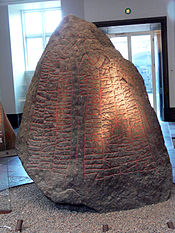Baltic rune stones
Distribution of the rune stones in Sweden |
The Baltic Sea rune stones are primarily rune stones of the Vikings from the Mälar region in Sweden , which were set up in memory of people who lost their lives in the Baltic States or Finland .

Sö 198, the rune stone from Mervalla
More than 130 rune stones Baltic (the Baltic States and Finland concerning, 14 stones), England- (30): are divided analogous to striking words used in seven groups Greece- Italy- (30), Hakon Jarl- (3), (2) , Ingvar (26) and about 30 Varangian rune stones, which are also available in Denmark and Norway in one copy each (for Russia, Belarus, Ukraine and neighboring areas).
Gästrikland
- Gs 13 is a rune stone made of sandstone in the church of Gävle in Gästrikland . It is reminiscent of Egill, who died in Tavastia or Tafeistaland (southwestern Finland) during a Leidang under the leadership of the Viking chief Freygeirr around 1050 AD. Freygeirr (Freyr's spear) is mentioned on another five rune stones. According to a more recent translation by Henrik Williams, the text should read: “Brusi put this stone in memory of Egill, his brother. And he died in Tafeistaland, where Brusi carried the long spear (= battle standard) after his brother. He was traveling with Freygeirr. May God and the mother of God help his soul. Sveinn and Ásmundr scratched the runes. "
Gotland

Runic stone G 135 of the church of Sjonhem
- G 135 one of the runic stones from Sjonhem tells of the same family as the stones G 134 and G 136. It was erected in memory of a man who died in Ventspils in Latvia .
- G 319 is a runic inscription on a grave slab (Swedish: Gravhälle) from the early 13th century in the church of Rute . It is reminiscent of Audvald, who died in Finland.
Södermanland
- Sö 39 is a runic inscription on a rock in Lifsinge. It is reminiscent of a brother who drowned in Livonia.
- Sö 198, the rune stone from Mervalla , is on the island of Selaön in Mälaren . It was erected in memory of a man who regularly sailed to Zemgale .
Uppland
- U 180 by Össeby-Garn is reminiscent of a man who died either in Viborg in Jutland or in Vyborg in Karelia .
- U 214 and U 215 from Vallentuna were built in memory of a man who drowned in Holmr's See. Jansson interprets it as the “Novgorod Sea” and refers to the Gulf of Finland .
- U 346 by Frösunda has only survived in drawings. He was raised for a man who died in Virland .
- Ängby's U 356 was set up for the son of a woman who died in Virland, Estonia. It contains the same message as U 346.
- U 439 from Steninge only exists as a drawing made by Johannes Bureus in 1595. Because of uncertainties in deciphering it both the word Virland and Serkland can contain and would be one of the Ingvar Runestones .
- U 533 by Roslags-Bro was built in memory of a man who fell in Estonia.
- U 582 from Söderby-Karl only exists as a drawing. It is reminiscent of a son who died in Finland.
- U 698 from Veckholm also only exists as a drawing. The inscription, which is difficult to read, refers to a man who died in Livonia , possibly during an expedition under the leadership of the Viking chief Freygeirr, around 1050 AD Freygeirr is found on five other rune stones (Gs 13, DR 216, U 518 and U 611) mentioned.
Västergötland
- Vg 181 ( Olsbrostenen ) was erected in memory of a man who fell in Estonia.
Denmark
- DR 216 from Tirsted on Lolland is the second largest rune stone in Denmark, which was erected in memory of a warrior who went to Sweden (Svitjod) and fought in the wake of a Freygeirr. It is one of the stones that prove that the Vikings also called themselves "vikingr".

DR 216 Runestone from Tirsted
literature
- Klaus Düwel , Anne-Sofie Gräslund: rune stones . In: Heinrich Beck , Dieter Geuenich , Heiko Steuer (Eds.): Reallexikon der Germanischen Altertumskunde Vol. 25, de Gruyter, Berlin / New York 2003, ISBN 3-11-017733-1 , pp. 585-596.
- Sven Birger Fredrik Jansson: Runstenar . STF, Stockholm 1980 ISBN 91-7156-015-7 .
- Lydia Klos: Runestones in Sweden. Studies on the place of installation and function (= Reallexikon der Germanischen Altertumskunde , supplementary volumes, 64). de Gruyter, Berlin / New York 2009, ISBN 978-3-11-021464-2 .
- Janine Köster: mortal inscriptions on rune stones from the Viking Age (= Real Lexicon of Germanic Antiquity, supplementary volumes , 89). de Gruyter, Berlin / Boston 2014, ISBN 978-3-11-034198-0 ( chargeable from de Gruyter -Online).
- Omeljan Pritsak : The Origin of Rus' . Distributed by Harvard University Press for the Harvard Ukrainian Research Institute. Cambridge, Mass. 1981, ISBN 0-674-64465-4 .
- Gothenburg University: References for Thunberg, Carl L. 2010. Ingvar and his monuments. A study by a runestone group suggested new grouping.

